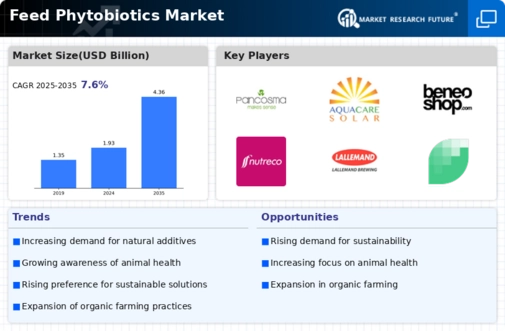Regulatory Support and Standards
The Feed Phytobiotics Market benefits from an evolving regulatory landscape that increasingly supports the use of natural feed additives. Governments and regulatory bodies are recognizing the importance of phytobiotics in promoting animal health and reducing reliance on antibiotics. This regulatory support is likely to enhance consumer confidence and encourage manufacturers to invest in phytobiotic products. Recent statistics suggest that the market is poised for growth as more countries implement favorable regulations. Such developments not only facilitate market entry for new players but also stimulate innovation within the Feed Phytobiotics Market, ultimately benefiting livestock producers and consumers alike.
Increasing Awareness of Animal Health
The Feed Phytobiotics Market is experiencing a notable surge in awareness regarding animal health and welfare. As consumers become more conscious of the quality of animal products, there is a growing demand for natural and safe feed additives. This trend is likely to drive the adoption of phytobiotics, which are perceived as healthier alternatives to synthetic additives. According to recent data, the market for feed additives is projected to reach substantial figures, with phytobiotics expected to capture a significant share. This increasing awareness not only influences purchasing decisions but also encourages manufacturers to innovate and expand their product lines, thereby enhancing the overall growth of the Feed Phytobiotics Market.
Rising Demand for Organic Livestock Products
The Feed Phytobiotics Market is significantly influenced by the rising demand for organic livestock products. As consumers increasingly seek organic options, producers are compelled to adopt practices that align with these preferences. Phytobiotics, known for their natural properties, are becoming essential in organic farming systems. Market analysis indicates that the organic livestock sector is expanding rapidly, with phytobiotics playing a crucial role in maintaining animal health and productivity. This trend not only supports the growth of the Feed Phytobiotics Market but also encourages the development of innovative solutions tailored to meet the specific needs of organic producers.
Shift Towards Sustainable Agriculture Practices
Sustainability is becoming a cornerstone of agricultural practices, influencing the Feed Phytobiotics Market. Farmers and producers are increasingly adopting sustainable methods to meet consumer demand for environmentally friendly products. Phytobiotics, derived from natural plant sources, align with these practices by promoting animal health without the adverse effects associated with chemical additives. The market data indicates a rising trend in the use of organic and natural feed solutions, with phytobiotics playing a pivotal role. This shift not only supports the health of livestock but also contributes to the sustainability of farming operations, thereby driving the growth of the Feed Phytobiotics Market.
Technological Innovations in Phytobiotic Development
Technological advancements are reshaping the Feed Phytobiotics Market, leading to the development of more effective and targeted phytobiotic products. Innovations in extraction and formulation techniques are enhancing the bioavailability and efficacy of phytobiotics, making them more appealing to livestock producers. Recent market data suggests that investments in research and development are on the rise, with companies striving to create novel phytobiotic solutions that address specific health challenges in animals. This focus on innovation not only drives competition within the Feed Phytobiotics Market but also ensures that producers have access to cutting-edge products that can improve animal health and productivity.

















